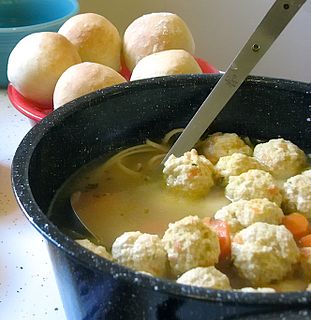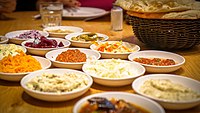
Couscous is a Maghrebi dish of small steamed balls of crushed durum wheat semolina that is traditionally served with a stew spooned on top. Pearl millet and sorghum, especially in the Sahel, and other cereals can be cooked in a similar way and the resulting dishes are also sometimes called couscous. Pearl or Israeli couscous, properly known as ptitim, is a type of pasta.

Kugel is a baked pudding or casserole, most commonly made from egg noodles or potato. It is a traditional Ashkenazi Jewish dish, often served on Shabbat and Yom Tov.

Jewish cuisine refers to the cooking traditions of the Jewish people worldwide. It has evolved over many centuries, shaped by Jewish dietary laws (kashrut), Jewish festival and Shabbat (Sabbath) traditions. Jewish cuisine is influenced by the economics, agriculture and culinary traditions of the many countries where Jewish communities have settled and varies widely throughout the whole world.

Cholent or hamin is a traditional Jewish stew. It is usually simmered overnight for 12 hours or more, and eaten for lunch on Shabbat. Cholent was developed over the centuries to conform with Jewish laws that prohibit cooking on the Sabbath. The pot is brought to a boil on Friday before the Sabbath begins, and kept on a blech or hotplate, or left in a slow oven or electric slow cooker, until the following day.

Iraqi cuisine or Mesopotamian cuisine has its origins from Sumerians, Akkadians, Babylonians, Assyrians, ancient Persians, Mesopotamian Arabs, and the other ethnic groups of the region. Tablets found in ancient ruins in Iraq show recipes prepared in the temples during religious festivals – the first cookbooks in the world. Ancient Iraq, or Mesopotamia, was home to a sophisticated and highly advanced civilization, in all fields of knowledge, including the culinary arts. However, it was in the Islamic Golden Age when Baghdad was the capital of the Abbasid Caliphate (750–1258) that the Iraqi kitchen reached its zenith. Today, the cuisine of Iraq reflects this rich inheritance as well as strong influences from the culinary traditions of neighbouring Iran, Turkey, and the Syria region area.

Kofta is a family of meatball or meatloaf dishes found in the Indian subcontinent, South Caucasian, Middle Eastern, Balkan, and Central Asian cuisines. In the simplest form, koftas consist of balls of minced or ground meat—usually beef, chicken, lamb, or pork—mixed with spices or onions. In the Indian subcontinent and the Middle East, koftas are usually made from lamb, beef, mutton or chicken, whereas Greek, Cypriot, and Balkan versions may use pork, beef, lamb, or a mixture of the three. In Greece and Cyprus there are also vegetarian versions known as hortokeftedes, often eaten during fasting periods such as Lent. An uncooked version is also made in Turkey, called Çiğ köfte. In India, vegetarian varieties include koftas made from potato, calabash, paneer, or banana. In Europe, kofta is often served in a fast-food sandwich in kebab shops.

Assyrian cuisine is the cuisine of the indigenous ethnic Assyrian people, Eastern Aramaic-speaking Syriac Christians of Iraq, northeastern Syria, northwestern Iran and southeastern Turkey. Assyrian cuisine is primarily identical to Iraqi/Mesopotamian cuisine, as well as being very similar to other Middle Eastern and Caucasian cuisines, as well as Greek cuisine, Levantine cuisine, Turkish cuisine, Iranian cuisine, Israeli cuisine, and Armenian cuisine, with most dishes being similar to the cuisines of the area in which those Assyrians live/originate from. It is rich in grains such as barley, meat, tomato, herbs, spices, cheese, and potato as well as herbs, fermented dairy products, and pickles.

Uzbek cuisine shares the culinary traditions of Turkic peoples across Central Asia. There is a great deal of grain farming in Uzbekistan, so breads and noodles are of importance, and Uzbek cuisine has been characterized as "noodle-rich". Mutton is a popular variety of meat due to the abundance of sheep in the country and it is a part of various Uzbek dishes.
Bukharan Jewish cuisine is the traditional cuisine originating from the Bukharian Jewish community of Central Asia, who now mostly reside in Israel, and the United States.

Sephardic Jewish cuisine is an assortment of cooking traditions that developed among the Sephardi Jews—the Jews of Spain and Portugal, and those of this Iberian origin who were dispersed in the Sephardic Diaspora, and ultimately became the Eastern Sephardim and North African Sephardim as they settled throughout the Mediterranean in places such as Turkey, Greece, the Balkans, as well as the Arab countries of West Asia and North Africa. Cuisine of the Sephardi Jews also includes the cuisine of those who became the Western Sephardim who settled in Holland, England, and from these places elsewhere.

Israeli cuisine comprises both local dishes and dishes brought to Israel by Jews from the Diaspora. Since before the establishment of the State of Israel in 1948, and particularly since the late 1970s, an Israeli Jewish fusion cuisine has developed.

Cocido madrileño is a traditional chickpea-based stew from Madrid, Spain. A substantial dish prepared with meat and vegetables, it is most popular during the winter but is served throughout the year in some restaurants.

Mizrahi Jewish cuisine is an assortment of cooking traditions that developed among the Jews of the Middle East, North Africa, Asia, and Arab countries. Mizrahi Jews have also been known as Oriental Jews. Jews of the Mizrahi communities cook foods that were and are popular in their home countries, while following the laws of kashrut. The cuisine is based largely on fresh ingredients, as marketing was done in the local souq. Meat is ritually slaughtered in the shehita process, and is soaked and salted. Meat dishes are a prominent feature of sabbath, festival, and celebratory meals. Cooked, stuffed and baked vegetables are central to the cuisine, as are various kinds of beans, chickpeas, lentils and burghul. Rice takes the place of potatoes.

A meatball is ground meat rolled into a small ball, sometimes along with other ingredients, such as bread crumbs, minced onion, eggs, butter, and seasoning. Meatballs are cooked by frying, baking, steaming, or braising in sauce. There are many types of meatballs using different types of meats and spices. The term is sometimes extended to meatless versions based on vegetables or fish; the latter are commonly known as fishballs.

Israeli style hummus is an Israeli variety of hummus, popular both in its place of origin, as well as at hummusiyot and fine dining restaurants serving Israeli cuisine abroad.
Ethiopian Jewish cuisine is the cuisine of the Beta Israel. The cuisine of the Ethiopian Jews is similar to the cuisine of other Ethiopians, with some variations. Because treyf foods such as pork and shellfish are not traditionally eaten by either Ethiopian Christians or Ethiopian Muslims, keeping kosher in Ethiopia is a largely invisible practice. However, there are some noticeable distinctions. Ethiopian Jews refrain from eating popular national dishes made from raw meat, such as kitfo and gored gored.
Ashkenazi Jewish cuisine is an assortment of cooking traditions that developed among the Jews of Eastern, Central, Western, Northern, and Southern Europe, and their diaspora mainly concentrated in North America and other Western countries. Ashkenazi Jews have also been known as Western Jews. Jews of the Ashkenazi communities cook foods that were often unique to their community, while often using local ingredients, and following the laws of kashrut. The cuisine is based largely on ingredients that were affordable for the historically poor Ashkenazi Jewish community of Europe, often composed of ingredients that were readily available in Europe and affordable and which were perceived to be less desirable and rarely used by their gentile neighbors, such as brisket, chicken liver, and artichokes, among other ingredients. As Ashkenazi Jews were typicall forbidden to grow crops in their home countries in Europe, their cuisine reflects that and there are less vegetable-focused dishes in Ashkenazi Jewish cuisine compared to their Sephardi and Mizrahi counterparts. Meat is ritually slaughtered in the shehita process, and is soaked and salted. Meat dishes are a prominent feature of sabbath, festival, and celebratory meals. Braised meats such as brisket feature heavily, as do root vegetables such as potatoes, carrots, and parsnips which are used in such dishes as latkes, matzo ball soup, and tzimmes. Cooked, stuffed and baked vegetables such as stuffed cabbage are central to the cuisine. Due to the lack of availability of olive oil and other fats traditionally used in Jewish cooking, fat from leftover chicken and goose skins (gribenes) called schmaltz is traditionally used in fleishig (meat) dishes, while butter is traditionally used in milchig (dairy) dishes.

Arab Indonesian cuisine is characterized by the mixture of Middle Eastern cuisine with local Indonesian-style. Arab Indonesians brought their legacy of Arab cuisine—originally from Hadhramaut, Hejaz and Egypt—and modified some of the dishes with the addition of Indonesian ingredients. The Arabs arrived in the Nusantara archipelago to trading and spread Islam. In Java, since the 18th century AD, most of Arab traders settled on the north coast and diffuse with indigenous, thus affecting the local cuisine culture, especially in the use of meat mutton and ghee in cooking.
















